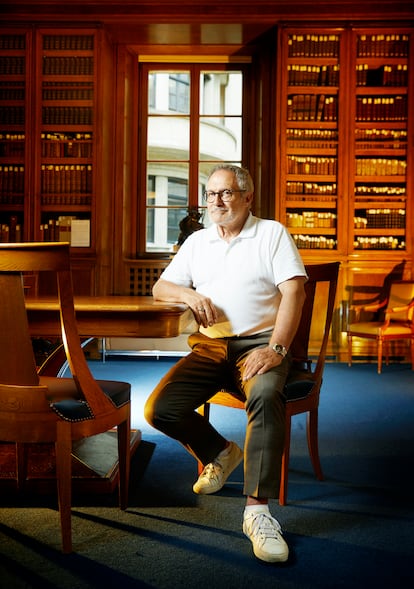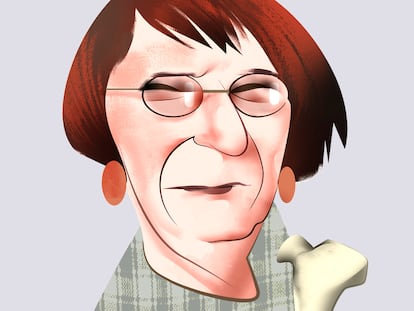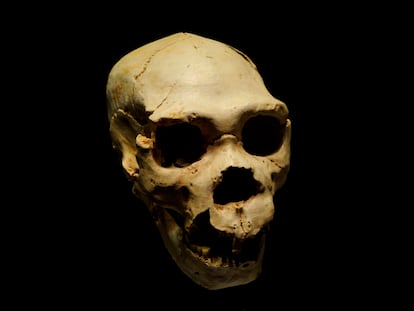Jean-Jacques Hublin, paleoanthropologist: ‘Evolution is the story of a great extinction’
In a conversation with EL PAÍS, one of the most respected paleoanthropologists in the world offers a heterodox look at his work as a researcher. He explains that prehistory brings up questions that are relevant to the present, from issues such as climate change to our relationship with technology

Rarely does a discovery change the history of humanity, as well as the image that human beings have of themselves. Alongside a team of Moroccan archeologists, the French paleoanthropologist Jean-Jacques Hublin, born 61 years ago in Algeria, discovered fossils belonging to Homo sapiens (the same species that we belong to) in Jebel Irhoud, Morocco. The fact that these remains — which are more than 300,000 years old, some of the oldest that have been found to date — were discovered in North Africa is a bit unexpected, given that it’s been indicated that the birth of our species took place in the south of the African continent.
This discovery has changed the geography of humanity. However, it has also blurred the boundaries between what is human and what is not; between our species and the rest of the natural world. In addition to being one of the most respected paleoanthropologists in the world, Hublin brings a deep and heterodox approach to his work as a researcher. He emphasizes that prehistory raises many questions that are relevant to the present, from issues such as climate change to our relationship with technology. The author of numerous essays, Hublin was the director of the Department of Human Evolution at the Max Planck Institute for Evolutionary Anthropology, in Leipzig, Germany. He has taught at numerous universities, from Harvard to Berkeley to Bordeaux.
Hublin currently holds the chair of Paleoanthropology at the Collège de France, a centuries-old French institution. Past members include Michel Foucault and Georges Duby. However, the researcher’s true place in the world is on the ground, in sites like Jebel Irhoud, where the past and present of humanity constantly shifts.
This interview took place at the Collège de France, in Paris, at the end of June.
Question. What does it mean to belong to the human species? And what exactly is the human species?
Answer. I don’t think there’s only a scientific answer: there’s also a metaphysical one. We would like there to be a clear border between the human and the non-human. In fact, for thousands of years, all cultures have defined this barrier between the world of men and the world of animals, who belong to nature. But the discovery of evolution led scientists to begin to question that frontier. It’s interesting because, if we go back to the 19th and 20th centuries, the obsession was all about finding the so-called missing link… a kind of intermediary between the world of primates and that of humans. However, fossils refute this theory.
Today, we continue to encounter this difficulty [when it comes to determining] what we should call “human” with respect to other hominids. There are all kinds of representatives of the genus Homo: Homo habilis, erectus, sapiens. But, in reality, the border is much less clear than we would like. In paleoanthropology, there’s a tendency to humanize as much as possible what we consider to be on the “good side” of the border. For me, this results in a big difficulty: there’s no clear barrier between the human and the non-human. [Although it’s somewhat] logical from the point of view of evolution.

Q. You’ve written that man doesn’t descend from apes… rather, man is an ape.
A. A very particular type of ape, yes. But it’s true that when we look at the great primates today and the relationship they have with each other in terms of closeness and common ancestors — though not in appearance — we realize that man is closer to the chimpanzee than the chimpanzee is to the orangutan. Scientifically, it doesn’t make much sense to put orangutans, gorillas, chimpanzees or bonobos in one group of great apes and humans in another, because man is very close to them. We could say that humans are very particular great apes, who’ve acquired original characteristics. It’s also important to remember that kinship shouldn’t be confused with similarity in appearance.
Q. You define Homo sapiens as being an orphaned and invasive species. How come?
A. For millions of years — because we know that the evolution of hominids takes between six and eight million years — there were different species that coexisted, sometimes in quite impressive numbers. In total, we know of 30 species of hominids, who sometimes lived together in the same regions. This is something that’s very difficult for us to imagine today, because for us, above all, man is unique. We’re the same everywhere, we’re a very homogenous species. But this situation has only occurred in a very recent period, because on a geological time scale 40,000 years is nothing. In that sense, we’re an orphaned species, because all our relatives have disappeared. And we’re invasive because our species, Homo sapiens, has colonized all possible natural environments, those that are habitable and those that are barely habitable, such as arctic areas, deserts and mountains. No species ever achieved that before us.
We’re invasive because our species establishes competition with other native species, ultimately driving many of them to extinction. And that’s what many of the species that we consider invasive do. The impact of a species on the environment isn’t a unique characteristic of sapiens, it existed before… but we’ve taken it to the limit. Instead of adapting to different environments, men adapt the environment to their needs. At first, they did this on a smaller scale, through fire, clothing, etc. [Although], even in the times of hunter-gatherers, there were large-scale environmental modifications, especially due to the use of fire to modify landscapes and also due to the impact on fauna. Currently, our species has taken total control of the planet, causing dramatic changes, such as with regards to the climate. There are many lessons from the past: Sapiens arrived in Australia and the megafauna disappeared. They arrived in Europe and the Neanderthals disappeared. They arrived in America and the megafauna also disappeared.
Q. Are we experts in destroying our environment?
A. I don’t know if I would use the word “destroy,” maybe because I’m an optimist. I think we can draw two big lessons from what we know about human evolution. One is that man modifies his environment… and this isn’t something that has only happened for centuries, it started two million years ago. In order to speak of the natural world, we would have to get rid of hominids completely. The second lesson is that humanity needs to draw energy from the world around it and use this energy to change the world. The key is whether this is done in a destructive way or in an intelligent way.
Q. Many prehistorians maintain that the absence of evidence isn’t necessarily evidence. They allege that we have a very biased view of the past, because of what may have disappeared over millions of years, or what hasn’t been found. Is this so?
A. There’s a metaphor that I use often, which I think sums up our attempt to understand remote prehistory: a drunk looks for his keys under the streetlamp, because it’s the only place with light. There are things about the past that we don’t know and that we’ll surely never know. We don’t know why they drew on the walls of the caves, what the [ancient] languages were like. The vast majority of the [material] has disappeared. Only a small part is illuminated, while the rest will remain in darkness forever.

Q. Do you think we’ll discover things that, until now, have remained in the dark?
A. Yes. Paleoanthropology is a very recent science. Humanity has been doing mathematics for thousands of years, but paleoanthropology dates back to just before yesterday; it began in the mid-19th century. This explains why so many revolutions have occurred in the way human evolution is conceived, because many discoveries have piled up in very few generations. But researchers and the public must be warned against a bias in documentation: the sites where hominid fossils are found are located in regions where these kinds of remains are preserved for reasons linked to geology or climate. When we see a map that shows the distribution of this or that group in the past, what it actually shows are the sites in which fossils have appeared, but we don’t know if [these sites paint] a reliable portrait of the past.
For a long time, we thought that there were only australopithecines (early human species) in eastern and southern Africa. [But that’s because] everyone went to look for fossils there. If you invest a lot of money in an excavation campaign, you want to come back with something and that’s easier to achieve in places where you’ve had luck in the past. But, suddenly, Australopithecus africanus appeared in Chad, very far from those regions.
That said, I’m pretty lukewarm about the idea that new discoveries could occur that completely change our view of the past. We often encounter those kinds of headlines in the press but in reality, it’s extraordinarily rare that these kinds of twists occur.
Q. But wasn’t Jebel Irhoud one of these rare instances when Homo sapiens — much older than previously thought — were found in North Africa?
A. Yes. But, in reality, what happens to the tree of human evolution is that it’s an image that becomes clearer with each new discovery. We see things that we didn’t see before but that doesn’t mean that we start the tree over again from scratch. It’s still more or less the same. Although, from time to time, we discover really new things.
When I was a young researcher preparing my thesis, I suffered a moment of crisis, because I thought that I was arriving too late, that all the important discoveries had already been made. [I felt that] I was arriving too late to a very old world. The Neanderthals, the Sapiens, had already been discovered. I thought it was impossible to go any further. I couldn’t have been more wrong. There have been enormous advances — in dating techniques, in genetics — that have changed the way we see things. I tell young researchers not to worry, many things are going to happen.
Q. That’s precisely what I was going to ask you. Don’t you think, for example, that the sequencing of Neanderthal DNA and the discovery that Homo sapiens have a percentage of Neanderthal genes — something done at the Max Planck Institute, where you worked — represented a true revolution?
A. Sure, but these are methodological revolutions. Revolutions occur in this sense: we suddenly discover a new technique that can reveal something we didn’t know. It’s true that the field of paleogenetics has allowed us to discover extraordinary things about the reproductive behavior of hominids who lived 50,000 years ago but what I do believe is that there’s a false impression that, when a new discovery occurs, this suddenly means that what we knew until now is erased, that we wipe the slate clean and start from scratch. But science doesn’t work like that: it moves by successive additions and corrections. It’s a building that is constantly being renovated, it’s always under construction. What we don’t do is demolish one building and replace it with another.
Q. But the discovery in northern Morocco of ancient sapiens changes history. It has determined that the species was much older than we thought, while also showing that it appeared in places where researchers had never previously searched for it.
A. It seems to me to be a very significant example, yes. [However], to a certain extent, this discovery is integrated into what we’ve known for a long time: that our species has an African origin. Now, saying that seems completely banal, but until recently, we didn’t imagine at all that our species had that origin. Paleoanthropology is a science that was born in Europe and, at the beginning of the 20th century, it was thought that sapiens had been born [there as well].
On the other hand, it’s true that such a discovery questions a model that has been maintained for quite some time: that there was a kind of Garden of Eden in western and southern Africa, where the oldest species of Homo sapiens are located. However, this discovery shows that older forms of Homo sapiens existed very far away [from those sites].
Another thing that has cast doubt on this discovery is the very idea of Homo sapiens. They are Homo sapiens because they share a series of characteristics particular to our species, especially in their teeth. But, at the same time, they have different, very primitive characteristics. They’re sapiens, but they’re not modern men, either. Anthropologists often use the term “modern men,” but I don’t like it. What does it mean? That they’re men like us because of their cognitive abilities, behavior, anatomy? In reality, there’s something called evolution… and that has never stopped in our species. The sapiens who lived 100,000 years ago are sapiens, but they weren’t exactly like us. We can call them “modern” if we want to. But are they? I don’t know. Those who lived 300,000 years ago were even more different.

Q. So you don’t agree that they resembled us.
A. I don’t know, because [it’s their faces] that most resemble modern humans. We wouldn’t be very surprised to run into them, although they would surely have rather impressive, very robust faces. But other characteristics, for example, the brain, are very different. In fact, thanks to the discoveries in northern Morocco, we’ve been able to understand that the brain of our species has evolved in a very different way from that of other closely related species, such as Neanderthals or Denisovans.
Q. Why do you think we’re so fascinated by Neanderthals? Is it because of the idea that there are many different ways of being human?
A. They fascinate us, but they’re also the subject of endless debates and controversies. I think it’s because [Neanderthals are] the last fork in the tree of evolution. They’re very close to us, but, simultaneously, clearly different. And this produces a schizophrenic effect on us: on the one hand, we want to [link ourselves] to the Neanderthals, as they were hominids with large brains and quite extraordinary behaviors. But, on the other hand, it’s clear that there’s a difference between Neanderthals and us, from the point of view of brain function, genetics…
Q. Why did they become extinct?
A. They’re the closest hominids to Homo sapiens. And it’s impressive that a species that managed to survive for 400,000 years ended up becoming extinct in a relatively short period. Evolution is the story of a great extinction. We often think of evolution as endless change, as the transformation of species into other things. In reality, what happens in evolution — and this is something that we see very clearly in hominids — is that life tries to adapt in every possible way to different conditions, but in the end, most species disappear. It’s true that there are sponges or sharks that haven’t changed for a long time. But — and it’s a word I’m not crazy about — more “developed” species tend to have a fairly short lifespan.
Q. In your lectures, you explain that the brain consumes a very important part of our energy as human beings and that this has marked evolution very clearly. Can artificial intelligence change that?
A. I think it’s a very interesting issue. Evolution can be narrated through the energy that the brain needs, because it’s an organ that consumes it enormously. For an adult, [the brain] consumes 20% [of our energy]... but for a six-year-old child, it consumes 60%. And what has happened throughout human evolution is that there’s been an outsourcing of some functions to save energy. At first, via purely mechanical processes, such as the transition to bipedalism, which is much more economical from an energy point of view. Also, because of everything that surrounds food: we invented tools that allow us to hunt, cut, grind meat and, later, cook it, which allows for enormous energy savings in the digestive system, as well as changes in our teeth. They no longer have to be so powerful, because these are foods that are easy to eat.
All the energy we save is invested in the brain. And, thanks to the brain, we invent more technical systems that accelerate this process. With writing — even in the past, with drawings on the walls of a cave — we externalize a part of our memory. Plato was already worried about this. He said that, in the ancient past, people knew many things by heart but they had no need to learn [after everything] was written down. And, in a very short and recent period of time, we’ve gone much further in that process. When we’re asked a question, our first reflex is to go to the phone and search on Wikipedia or Google. We’ve outsourced our ability to calculate to computers. And now, we’ve started to outsource part of our intelligence to AI systems. In the end, maybe we’ll use our brains for something else.
Sign up for our weekly newsletter to get more English-language news coverage from EL PAÍS USA Edition
Tu suscripción se está usando en otro dispositivo
¿Quieres añadir otro usuario a tu suscripción?
Si continúas leyendo en este dispositivo, no se podrá leer en el otro.
FlechaTu suscripción se está usando en otro dispositivo y solo puedes acceder a EL PAÍS desde un dispositivo a la vez.
Si quieres compartir tu cuenta, cambia tu suscripción a la modalidad Premium, así podrás añadir otro usuario. Cada uno accederá con su propia cuenta de email, lo que os permitirá personalizar vuestra experiencia en EL PAÍS.
¿Tienes una suscripción de empresa? Accede aquí para contratar más cuentas.
En el caso de no saber quién está usando tu cuenta, te recomendamos cambiar tu contraseña aquí.
Si decides continuar compartiendo tu cuenta, este mensaje se mostrará en tu dispositivo y en el de la otra persona que está usando tu cuenta de forma indefinida, afectando a tu experiencia de lectura. Puedes consultar aquí los términos y condiciones de la suscripción digital.
More information
Archived In
Últimas noticias
Most viewed
- Sinaloa Cartel war is taking its toll on Los Chapitos
- Oona Chaplin: ‘I told James Cameron that I was living in a treehouse and starting a permaculture project with a friend’
- Reinhard Genzel, Nobel laureate in physics: ‘One-minute videos will never give you the truth’
- Why the price of coffee has skyrocketed: from Brazilian plantations to specialty coffee houses
- Silver prices are going crazy: This is what’s fueling the rally











































